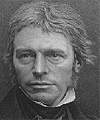|
|
 Static electricity was discovered in 600 B.C., but it was not until the mid 1700's when energy storage properties were discovered.
Static electricity was discovered in 600 B.C., but it was not until the mid 1700's when energy storage properties were discovered.
'With the discovery of the first Leyden jar, it was referred to as a condenser because electricity was thought of as a fluid which could condense. The Lehden jar is a glass partially filled with water that has a wire inserted through the top of an insulating stopper (cork). When the wire is charged by static electricity, it holds the charge until the wire comes into contact with a conductor which will discharge the glass.
It was roughly one hundred years later when Michael Faraday discovered a variable capacitor. He did this by measuring the varying capacitance of different dielectrics on capacitor.'(4)
When the first aluminum capacitor was discovered, some thirty years after Faraday's work, the SI unit used measuring capacitance was named a farad (F) in his honor.
1F = 1 C / V
In words: one Farad is equal to one Coulomb per Volt
Since the farad is a large unit of capacitance, most capacitors have units of picofarads (pF) or nanofarads (nF). To this day only one type of capacitor has the ability to store enough energy to warrant measurements using a farad as the standard unit, and this is the super capacitor.
A capacitor consists of two conducting surfaces separated by an insulator (dielectric). The value of capacitance depends not only on the geometry of the capacitor, but the dielectric as well. (1)
The picture inserted below shows the variation of capacitance, geometry, and voltage.
 From Left to Right
From Left to Right
{C(uF),V,dmtr(mm),hgt(mm)}
{1,50,5,5,12}
{47,16,6,5,}
{100,25,5,11}
{220,25,8,12}
{1000,50,18,40}